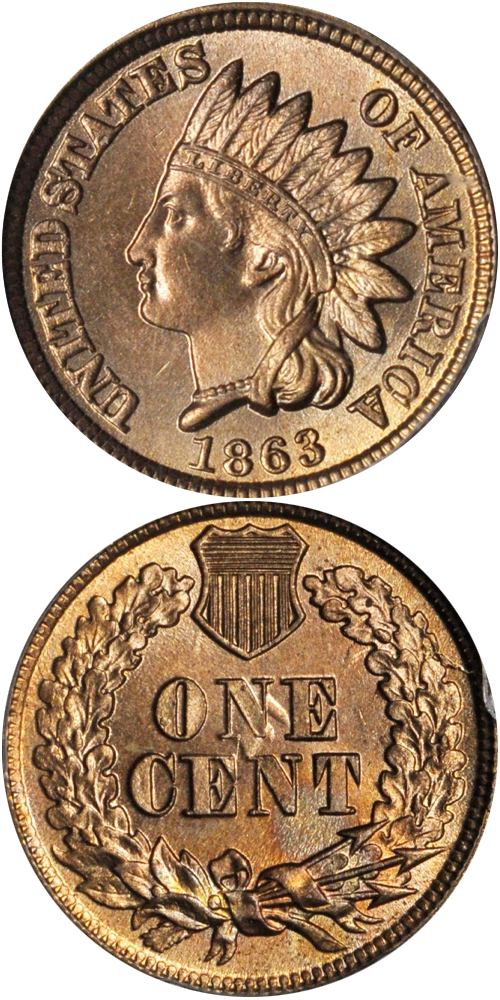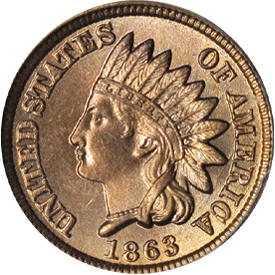Designed by: James Barton Longacre
Issue Dates: 1860-1864
Composition: 88% copper, 12% nickel
Diameter: 19 mm
Weight: 4.66 grams (72 grains)
Edge: Plain
Business Strike Mintage: 122,321,000
The Indian head cent, designed by James B. Longacre and introduced into the coinage system in 1859, was struck in copper-nickel alloy (88% copper and 12% nickel) from that point through the middle of the Civil War. During that conflict, coins of all types were hoarded, including copper-nickel cents. In their place appeared thousands of different varieties of privately-issued cent-size tokens struck in bronze. These were readily accepted by the public. The situation did not go unnoticed at the Mint, and soon a proposal was made to drop the copper-nickel metal, which had caused many striking difficulties due to its hardness, and replace it with bronze. This was done in 1864. Apart from the metallic composition, the format remained the same as used earlier. Later in 1864, a tiny L, the initial of Longacre, was added inconspicuously on the obverse.
Although there are a number of scarce varieties within the 1864-1909 span, including 1864 with Lon ribbon, there are enough common dates that obtaining a specimen in any desired condition presents no problem. Examples are easily available in grades from Good through Uncirculated, although pristine, superb Uncirculated pieces are becoming increasingly scarce.
Further Reading
Following the adoption of copper-nickel metal, beginning in 1857 for coinage of Flying Eagle cents, pieces were struck from this hard alloy. The Mint experienced many problems. Included were difficulties in preparing the planchets and rapid die wear due to the hardness of the metal. This metal hardness situation continued after the change to the Indian head design in 1859. It was proposed that a thin copper or bronze format be adopted, but this was rejected on the theory that the pieces would not be "substantial" enough to be accepted by the public.
When thin bronze Civil War tokens were circulated by the millions in 1863 and were being accepted by citizens and merchants alike as being worth one cent in trade value, the Mint took sharp notice. The public was willing to accept lightweight bronze coins after all!
Proof dies for the 1863 copper-nickel cent were used to strike a number of pattern cents on thin bronze planchets. Perhaps to differentiate these from copper-nickel issues (although such differentiations weren't needed, as the metal differed in coloration), the dies were misaligned 180 degrees, so that the obverse and reverse of each trial striking were oriented in the same direction (whereas on regular issues the obverse and reverse are aligned in opposition). These particular pattern issues, listed as Judd-299, were struck to the extent of hundreds of specimens. They are particularly significant for they were the forerunners of the small bronze cents which were used for more than a hundred years afterward (with the exception of 1943).
At the beginning of 1864 the old copper-nickel standard was in effect, but soon the new bronze cent, a coin of thinner format weighing only 48 grains (in comparison to 72 grains for the copper-nickel issue), became the standard.
Setting aside Indian cents was a popular pastime of many storekeepers during the 1940s. When I first started collecting in the early 1950s, Indian cents had all but disappeared from circulation. In looking through a bag of 1,000 cents obtained at a local bank, representing $10 face value, I would be lucky to find one or two Indian pieces, usually of such dates as 1905, 1907, or some other common issue, worn nearly smooth. Within a few years none there were to be seen. However, hope springs eternal, and in 1983 a Bethlehem, New Hampshire collector found a 1905 Indian cent in circulation (big deal – it was worth about 50¢).
Uncirculated pieces with full original mint color are scarce for issues dated prior to 1879. Later Indian cents, although much more plentiful in worn grades, still are not seen with great frequency in high states of preservation. It is an unfortunate commentary on the market for Indian (and early Lincoln) cents that the majority of "Choice brilliant Uncirculated" pieces advertised owe their "brilliance" to dipping or cleaning. Most of these are simply Extremely Fine, AU, or brown Uncirculated pieces that have been given the artificial appearance of brilliant Uncirculated.
This situation, although existing for a number of years, blossomed around 1960 when an enterprising dealer discovered that vast numbers of new collectors were coming into the market, people who could read advertisements and who knew that "brilliant Uncirculated" was a good condition to own, but didn't know the first thing about how to determine the grade. A few minutes spent cleaning an Extremely Fine coin and, presto, a coin worth $1 or $2 magically became worth $50. Or, so it appeared. To stimulate sales, these pieces, really worth $50 if they had truly been brilliant Uncirculated, were advertised at discount prices, say, $20 to $30. As readers of popular periodicals could not determine which ones were truly in the grades stated and which ones were not, and as the periodicals themselves did little in the way of policing advertisers, the result followed Gresham's Law: the bad drove out the good. Soon the market for all Indian cents weakened, as collectors were confused and disoriented. Twenty years later the appeal of collecting Indian cents in higher grades had not fully recovered.
At the same time, it should be mentioned that the collector or dealer with an experienced eye can quickly determine such pieces, so they pose no real threat. However, there is an apparent threat, and this has deterred many would-be buyers. The pricing structure of legitimate Choice Brilliant Uncirculated pieces is thus much, much lower than it really should be, resulting in a windfall of a sort for experienced numismatists who can purchase beautiful coins, when they can be located, for prices that are probably fractions of what they otherwise should be!
The type set collector will find that any Indian cent of the 1900s will suffice. Issues in this range are plentiful in all grades. I advise that the date collector adopt a condition standard and try to stick to it. For example, issues prior to 1879 might be collected in Fine grade, while later pieces (which are less expensive) might be in Extremely Fine preservation. Of course, those who can afford it would be advised to assemble Uncirculated or Proof pieces, taking care to avoid misrepresented items.
Indian head "pennies" were part of the American scene for a long time, from 1859 to 1909. Today a well-worn example has an interesting tale to tell – where has it been, what has it seen? Such items are in¬ credibly romantic. As child in Honesdale, Pennsylvania, I once saw a group of Indian cents imbedded face-up in a concrete doorstep. Never having seen such pieces before, and realizing that they were at once unusual and rare, I desired to own one. Shortly thereafter, at an auction held as part of a church benefit, an iron bank full of pennies came up for sale. I had seen it earlier, and peering through the latticework of the toy bank I saw Indian cents within. But the price realized for the bank and contents was $3, far more than an eight-year-old could afford at the time.







